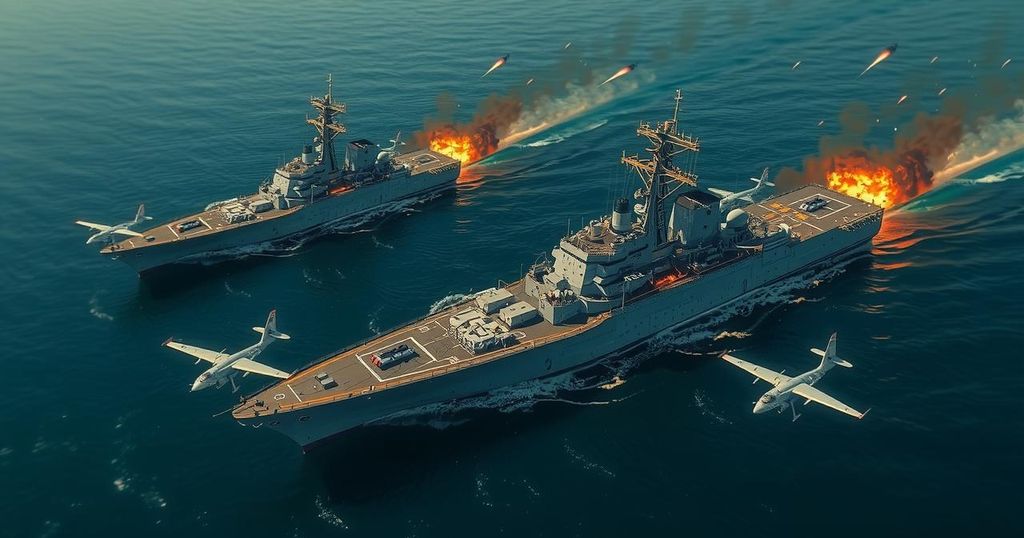On Monday, U.S. Navy destroyers USS Stockdale and USS Spruance were attacked by Houthi rebels utilizing drones and missiles. The Pentagon confirmed successful interception of these threats and subsequent airstrikes targeting Houthi weapons storage facilities. This marks a notable rise in aggression from the Houthis against U.S. forces, amidst broader tensions involving Iranian-backed militias in the region.
On Monday, two U.S. Navy destroyers, the USS Stockdale and USS Spruance, were targeted by an assault of missiles and drones launched by Houthi rebels while navigating the maritime corridor between Yemen and Djibouti. According to Major General Pat Ryder, the Pentagon press secretary, the incursion involved at least eight uncrewed aerial systems, five anti-ship ballistic missiles, and three anti-ship cruise missiles; however, all were successfully intercepted. Subsequently, the U.S. Navy and Air Force conducted a series of airstrikes aimed at Houthi weapon storage facilities that reportedly contained advanced weaponry designed to target military and civilian vessels in the Red Sea. The recent attacks by the Houthis, who enjoy Iranian support, reflect a troubling trend of increased violence in the region, particularly aimed at international shipping and U.S. naval operations safeguarding vital trade routes. The prompt response from U.S. forces, which included airstrikes targeted at Houthi infrastructure, indicates a firm commitment to countering threats posed by the rebels. U.S. Central Command corroborated the retaliatory operations through a social media update showcasing various aircraft engaged against Houthi positions. Amid escalating tensions, this attack marks the first instance in several weeks where U.S. naval vessels encountered direct assaults involving missiles and drones since a notable attack in late September. It also comes on the heels of attacks against American forces in Syria by other Iranian-affiliated groups. In light of these developments, it is essential to comprehend the increasing hostility of the Houthis and their aggressive posture toward both military and commercial maritime interests in the region, as evidenced by their recent claims of targeting the USS Abraham Lincoln—denied by Navy officials. As the conflict continues to evolve, and with a considerable number of engagements documented in the last year, including multiple instances involving U.S. warships under enemy fire, the U.S. Navy remains resolute in protecting its operational interests. The award of the Combat Action Ribbon to several ships signals both valor and preparedness in confronting such threats, contributing to the Navy’s legacy as one of the most battle-tested fleets in contemporary history.
The ongoing conflict in Yemen has led to significant instability in the region, with Houthi rebels, who receive backing from Iran, increasingly targeting military and civilian maritime activities. The strait between Yemen and Djibouti represents a crucial chokepoint for international shipping, making it a focal point for military operations by the U.S. and its allies. In response to the Houthi threat, U.S. naval forces have been deployed to ensure the safety of vital trade routes, resulting in several encounters with Houthi forces over the past several months. This attack on U.S. destroyers reflects a continuation of the pattern of aggression that has characterized Houthi actions against foreign military assets in the area, as well as broader geopolitical tensions involving Iran.
The attacks on USS Stockdale and USS Spruance by Houthi rebels underscore a heightened level of aggression in the region, prompting a robust U.S. military response to protect vital maritime interests. These recent incidents, combined with previous confrontations involving Iranian-backed groups, highlight the ongoing volatility in the Gulf region and the significant threat posed to international shipping and security. As the U.S. Navy remains vigilant and prepared to respond to such provocations, the potential for further escalation remains a pressing concern for regional stability.
Original Source: www.military.com






